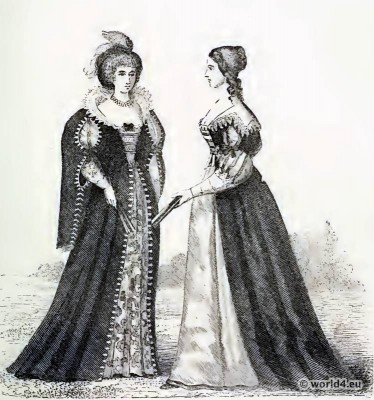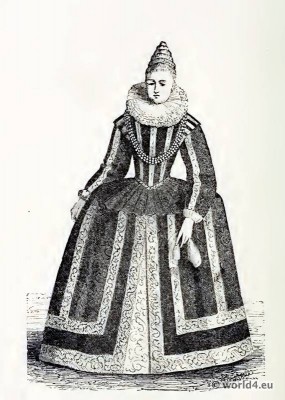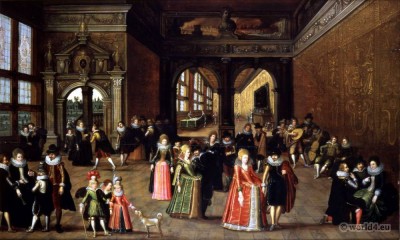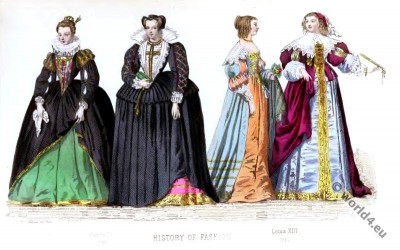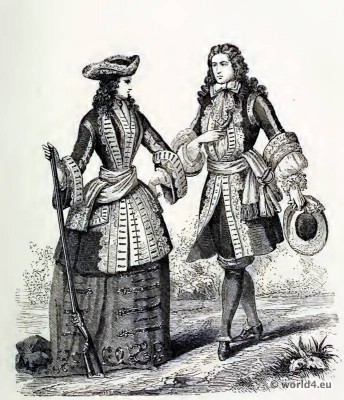Corsets and Crinolines 1st Edition by Norah Waugh & Judith Dolan.
In this classic book, Norah Waugh explores the changing shapes of women’s dress from the 1500s to the 1920s. Simple laced bodices became corsets of cane, whalebone and steel, while padding at shoulders and hips gave way to the structures of farthingales, hoops and bustles.
Stays and Corsets: Historical Patterns Translated for the Modern Body by Mandy Barrington.
Using her original pattern-drafting system, author Mandy Barrington will show you how to draft a historical pattern for a modern body shape, while still retaining an accurate historical silhouette.
CHAPTER V. Maria de’ Medici — The distended dresses of her time.
Contents:
Strange freaks of Louise de Lorraine – One of her adventures – Her dress at a royal fête – Maria de’ Medici- The distended dresses of her time – Hair-powder – Costume a la enfant – Escapade of the young Louis – Low dresses of the period – The court of Louis XIV. of France – High heels, slender waists, and fancy costumes – The Siamese dress – Charles I. of England – Patches introduced – Elaborate costumes of the period – Puritanism, its effect, on the fashions – Fashions in Cromwell’s time, and the general prevalence of the practice of tight-lacing – The ladies of Augsburg described by Hoechstetterus.
Strange freaks of Louise de Lorraine
Little change appears to have taken place in the prevailing fashions of England for some considerable time after this period. In France two opposing influences sprang up. Henry III., as we have seen, was the slave of fashion, and mainly occupied his time in devising some new and extravagant article of raiment. His wife, Louise de Lorraine-Vaudémont (1553 – 1601 also called: Louise de Mercœur, La Reine Blanche), on the other hand, although exceedingly handsome, was of a gloomy, stern, and ascetic disposition, dressing more like a nun than the wife of so gay a husband.
She caused numerous sumptuary laws to be framed, in order to, if possible, reduce the style of ladies’ dress to a standard nearer her own; and the following anecdote will serve to show the petty spirit in which her powers were sought to be exercised.
A writer on her life says, “She was accustomed to go out on foot with but a single attendant, both habited plainly in some woollen fabric, and one day, on entering a mercer’s shop in the Rue St. Denis, she encountered the wife of a president tricked out superbly in the latest fashions of the day.

The subject did not recognise the sovereign, who inquired her name, and received for answer that she was called ‘La Présidente de M.,’ the information being given curtly, and with the additional remark, ‘ to satisfy your curiosity.’ To this the queen replied, ‘But, Madame la Présidente, you are very smart for a person of your condition.’ Still the interrogator was not recognised, and Madame la Présidente, with that pertness so characteristic of ordinary womankind, replied, ‘At any rate, you did not pay for my smartness.’
Scarcely was this retort completed when it dawned upon the speaker that it was the queen who had been putting these posing questions, and then a scene followed of contrite apology on the one hand, and remonstrance on the frivolity of smart attire on the other, both very easy to imagine.” With all this pretended simplicity and humility, Queen Louise, on certain occasions, indulged in the most lavish display of her personal attractions. It is related of her that on the marriage of her sister Margaret, she attended a magnificent fête given at the Hôtel de Bourbon, and made her appearance in the saloon or grand ball-room as the leader of twelve beautiful young ladies, arrayed as Naiads.
The queen wore a dress of silver cloth, with a tunic of flesh-coloured and silver crépes over it; on her head she wore a splendid ornament, composed of triangles of diamonds, rubies, and various other gems and precious stones. Still the king was the acknowledged leader of fashion, which the queen did all in her power to suppress, except when it suited her royal caprice to astonish the world with her own elegance.
Maria de’ Medici. The distended dresses of her time.
Henry IV. appears to have had no especial inclination for matters relating to fashion, and the world wagged much as it pleased so far as he was concerned. On his marrying, however, his second wife, Marie de Medici, another ardent supporter of all that was splendid, sumptuous, and magnificent was found.
His first wife, indeed, Marguerite de Valois, had strong fashionable proclivities, but she was utterly eclipsed by the new star, whose portrait is the subject of the accompanying illustration, in which it will be seen that the wide hips and distended form of dress accompany the long and narrow waist.
This style of costume remained popular, as did hair-powder, which was introduced in consequence of the grey locks of Henry IV., until the boy-king Louis XIII., who was placed under the control and regency of his mother, caused by his juvenile appearance a marked change in the fashions of the time. The men shaved off their whiskers and beards, and the ladies brushed back their hair à l’enfant, and as about this time Marie showed strong indications of a tendency towards portliness, the hoops were discarded; and short waists; laced to an extreme degree of tightness, long trailing skirts, and very high-heeled shoes were introduced.
The dresses of this period of sudden change were worn excessively low, and it is said of young Louis that he was so alarmed, enraged, and astonished at the sight of the white shoulders of a lady of high position that he threw a glass of wine over them, and precipitately quitted the scene of his discomfiture. The annexed illustration shows the style of dress after the changes above referred to.
The court of Louis XIV. of France
The next noteworthy changes we shall see taking place during the reign of Charles I. in England and Louis XIV. of France. The court of the Grand Monargue was one of extraordinary pomp and magnificence; flowing ringlets, shoes with heels of extraordinary height, and waists of extreme slenderness were the rage. Fancy costumes were also much affected.
The accompanying illustration represents a lady and gentleman of the period equipped for the chase, but of what it would be difficult to say, unless butterflies were considered in the category of game. The so-called Siamese dress, which became so generally popular, was worn first during the reign of Louis XIV.
Many of these dresses were extremely rich and elegant; one is described as having the tunic or upper-skirt composed of scarlet silk with brocaded gold flowers. The under-skirt was of green and gold, with frills of exquisite work from the elbow to the wrist. The accompanying illustration represents a court lady dressed in this style, and that which follows it a fancy dress of the same period. It was in this reign that the coloured and ornamented clocks to ladies’ stockings first made their appearance.
Patches for the face were first worn in England during the reign of Charles, although they continued in use for a great number of years, and the following satirical lines were written by an old author regarding them and one of their wearers:
“Your homely face, Flippanta, you disguise
With patches numerous as Argus’ eyes;
I own that patching’s requisite for you,
For more we’re pleased the less your face we view,
Yet I advise, since my advice you ask,
Wear but one patch, and be that patch a mask.”
Puritanism, its effect, on the fashions
The fashions set by the court of Louis were eagerly seized on by the whole of Europe. The flowing curls, lace cuffs, and profuse embroidery in use at the court of Charles of England were all borrowed from France, but the general licence and laxity of the period for some short time showed itself in the dress of the ladies, whilst fickleness and love of change, accompanied by thoughtless luxury and profusion, prevailed.
The following complaint of a lady’s serving-man, dated 1631, will show that the Puritans were not without reason in condemning the extravagances of the time:
“Here is a catalogue as tedious as a taylor’s bill of all the devices which I am commanded to provide (videlicet):
Chains, coronets, pendants, bracelets, and earrings,
Pins, girdles, spangles, embroidaries, and rings,
Shadomes, rebatacs, ribbands, ruffs, cuffs, falls,
Scarfs, feathers, fans, maskes, muffes, laces, cauls,
Thin tiffanies, cobweb lawn, and fardingales,
Sweet sals, vyles, wimples, glasses, crumping pins,
Pots of ointment, combs, with poking-sticks, and bodkins,
Coyfes, gorgets, fringes, rowels, fillets, and hair laces,
Silks, damasks, velvets, tinsels, cloth of gold,
Of tissues with colours a hundredfold,
But in her tyres so new-fangled is she
That which doth with her humour now agree,
To-morrow she dislikes; now doth she swear
That a losse body is the neatest weare,
But ere an hour be gone she will protest
A strait gown graces her proportion best.
(104) Now calls she for a boisterous fardingale,
Then to her hips she’ll have her garments fall.
Now doth she praise a sleeve that’s long and wide,
Yet by and by that fashion doth deride;
Sometimes she applauds a pavement-sweeping train,
And presently dispraiseth it again;
Now she commands a shallow band so small
That it may seem scarce any band at all;
But now a new fancy doth she reele,
And calls for one as big as a coach-wheele;
She’ll weare a flowry coronet to-day,
The symbol of her beauty’s sad decay;
To-morrow she a waving plume will try,
The emblem of all female levitie;
Now in her hat, then in her hair is drest,
Now of all fashions she thinks change the best.”
Fashions in Cromwell’s time
On Puritanism becoming general the style of dress adopted by the so-called “Roundheads,” as a contrast to that of the hated “Cavaliers,” was stiff, prim, and formal to a degree; and during Cromwell’s sway as Protector, small waists, stiff corsets, and very tight lacing again became the fashion; and Bulwer, who writes in 1653, in speaking of the young ladies of his day, says, “They strive all they possibly can by streight lacing themselves to attain unto a wand-like smallness of waist, never thinking themselves fine enough until they can span their waists. “The annexed illustration, adapted by us from his work, The Artificial Changeling, represents a young lady who has achieved the desired tenuity.
He also quotes from Hoechstetterus, who in his description of “Auspurge, the metropolis of Swevia,” 1653 (meaning Augsburg, the capital of Suabia), “They are,” saith he, describing the virgins of Auspurge, “slender, streight laced, with ‘demisse’ (sloping) shoulders, lest being grosse and well made they should be thought to have too athletique bodies.” So throughout the length and breadth of Europe the use of tightly-laced corsets remained general.
Source: The Corset and the Crinoline. A Book of Modes and Costumes from remote Periods to the Present Time by W. B. L. (William Berry Lord). With 54 Full-Page and other Engravings. London: Ward, Lock, and Tyler. Warwick House, Paternoster Row. 1868.
Corsets and Crinolines 1st Edition by Norah Waugh & Judith Dolan.
In this classic book, Norah Waugh explores the changing shapes of women’s dress from the 1500s to the 1920s. Simple laced bodices became corsets of cane, whalebone and steel, while padding at shoulders and hips gave way to the structures of farthingales, hoops and bustles.
Stays and Corsets: Historical Patterns Translated for the Modern Body by Mandy Barrington.
Using her original pattern-drafting system, author Mandy Barrington will show you how to draft a historical pattern for a modern body shape, while still retaining an accurate historical silhouette.






